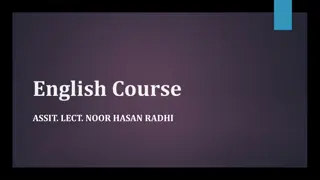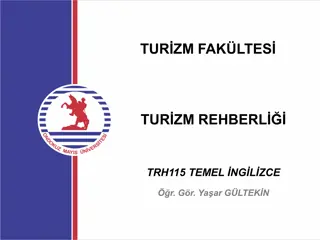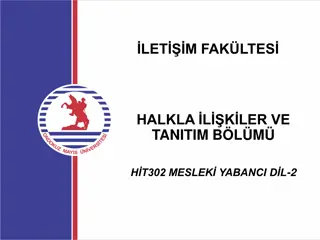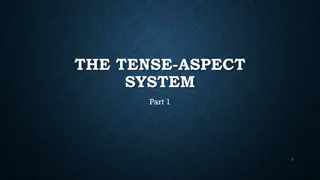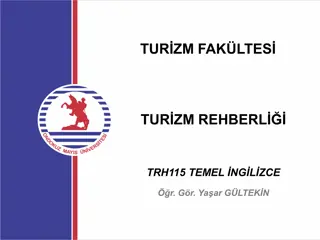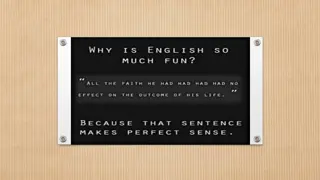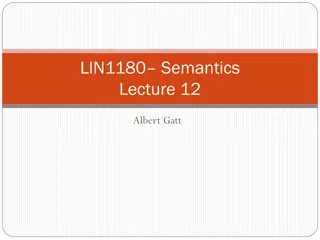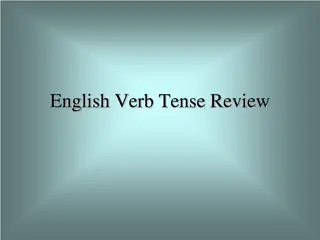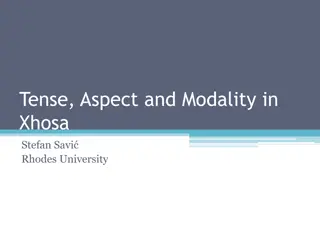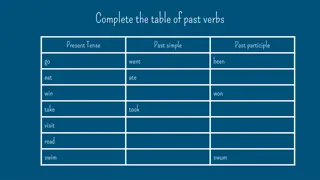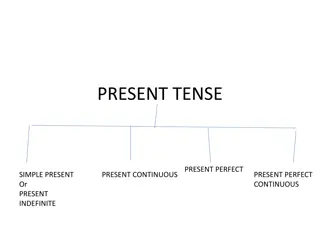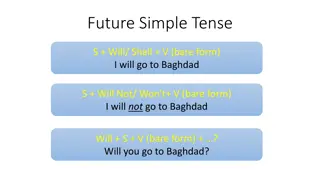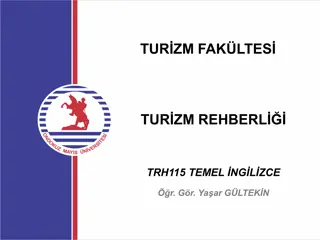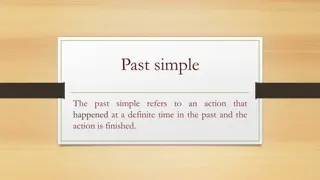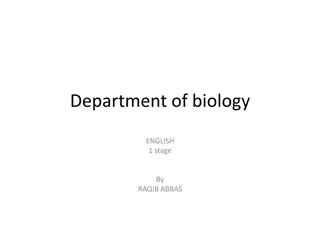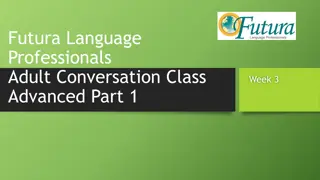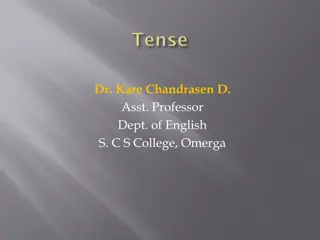Understanding Tense and Aspect in Language Learning
Exploring the concepts of tense and aspect in language, this study delves into absolute, relative, and metrical tenses, illustrating how different languages express time relationships. It highlights the past, present, and future tenses, as well as relative tenses like past perfect, future perfect, and present perfect, offering insight into how these linguistic features shape our perception of events.
Download Presentation

Please find below an Image/Link to download the presentation.
The content on the website is provided AS IS for your information and personal use only. It may not be sold, licensed, or shared on other websites without obtaining consent from the author. Download presentation by click this link. If you encounter any issues during the download, it is possible that the publisher has removed the file from their server.
E N D
Presentation Transcript
Language Awareness for Key Stage 3 10: Tense and Aspect 1
Roadmap Today we will look at two properties that verbs can have: tense and aspect We will look at three types of tense: absolute tense, relative tense, and metrical tense We will see how different languages form tenses in different ways We will also see how aspect gives us different ways of looking at the same event 2
Tense You may remember that verbs normally describe events Tense lets people locate these events in time, to talk about them One way to think about tense is in terms of a timeline: Past Present Future 3
Tense Different tenses locate events at different points along this line You ran You run You will run Past Present Future 4
Absolute Tense The past, present, and future tenses in English are absolute tenses They only express the relationship between the time of an event and the present 1. You ran (before the present) 2. You run (at the present) 3. You will run (after the present) 5
Relative Tenses There are also relative tenses Relative tenses express a three-way relationship among the present, the time of an event, and another point in time. The English past perfect, present perfect, and future perfect are relative tenses 6
Past Perfect The past perfect introduces a new point in time in the past: 4. They had been to France already before last year Last year France Past Present Future 7
Future Perfect The future perfect introduces a new point in time in the future: 5. They will have been to France by next year Next year France Past Present Future 8
Present Perfect The present perfect introduces a new point in time at the present: 6. They have been to France already Now France Past Present Future This is useful for emphasising the relationship between a past event and the present 9
Metrical Tenses All the tenses we ve seen so far are based on a simple division of time into past, present, and future The past tense tells you that an event happened in the past, but it doesn t tell you when in the past it happened However, some languages have tenses that refer to more specific periods of time Tenses that make these finer distinctions are called metrical tenses 10
Metrical Tenses One such language is Aymara, which is spoken in Peru Aymara has a recent past tense, for things that happened recently, and a remote past tense, for things that happened longer ago 7. Akankaskataynax She was here (recently) 8. Akankaskanx She was here (long ago) 11
Metrical Tenses Akankaskanx Akankaskataynax Past Present Future 12
Metrical Tenses There are languages closer to home that can also make this sort of distinction French has a special way of referring to the recent past 9. Elle vient d tre ici She s just been here (literally, She s coming from being here ) Other languages have systems that are even more complicated, with one tense for earlier today and another tense for yesterday 13
Tense Formation As these examples show, French uses a combination of verbs to express what Aymara expresses with a special form of a single verb You may remember that verbs used with other verbs in this way are called auxiliaries Languages differ in whether they use auxiliaries, and where they use them 14
Activity Some of you may know languages other than the ones that we ve discussed here Take some time to make a list of these languages and count their tenses You can include simple tenses and those formed with an auxiliary Which languages have the most tenses? Which languages have the fewest? 15
Tense Formation In English, the only tenses formed without an auxiliary are the present and the past 10.They stand 11.They stood All other tenses require at least one auxiliary 12.They will stand 13.They have stood 14.They had stood 15.They will have stood 16
Tense Formation Other languages, such as Latin, can form all these tenses without auxiliaries: 16.Stant They stand 17.Stabant They stood 18.Stabint They will stand 19.Steterunt They have stood 20.Steterant They had stood 21.Steterint They will have stood 17
Tense Formation As a rule of thumb, the more basic a tense is, the less likely it is to need an auxiliary For example, there are more language that use auxiliaries for the future perfect (will have stood) than for the present (stand) 18
Tense Formation Different languages often choose similar auxiliaries for the same tenses For example, it is quite common for languages to use verbs meaning have for the perfect 22.I have sung (English) 23.J ai chant (French) 24.Ich habe gesungen (German) 19
Tense Formation Another common auxiliary for the perfect is be Some languages use have with some verbs and be with others, as in French: 25.J ai chant I have sung 26.Je suis tomb I have fallen (literally, I am fallen ) In these languages, the verbs most likely to use be refer to motion (e.g. come , go ) or a change of state (e.g. become , be born , die ) 20
Tense Formation Other languages use be for the perfect of all verbs, as in Finnish: 27.Olen laulanut I have sung (literally, Am sung ) Finnish (like Irish) is a language without a verb meaning have Instead of I have a book , people say A book is at me 21
Tense Formation Irish doesn t use an auxiliary for the perfect at all Instead, Irish uses prepositions to form these tenses 28.T m tar is am I after I have sung Varieties of English that have been influenced by Irish do the same thing 29.I m after singing For some people this is a recent past, like in Aymara and French For other people, it simply means I have sung canadh singing 22
Activity Consider these two sentences: 30.I m going to Paris 31.I m going to go to Paris Do you notice any differences between the two goings? How would you describe this difference? 23
Solution 24
Solution 30.I m going to Paris 31.I m going to go to Paris In the second sentence, going is being used as an auxiliary It provides a way of referring to future time 25
Aspect The type of distinction expressed by aspect can be seen most easily by looking at examples from English: 32.I was closing the door 33.I closed the door In both these examples, the closing takes place at some point in the past So what is the difference? 26
Aspect The type of distinction expressed by aspect can be seen most easily by looking at examples from English: 32.I was closing the door 33.I closed the door These examples have different aspects In the first sentence, the progressive (or continuous) past means that the door is still open, but closing is in progress In the second sentence, the simple past makes it clear that closing is complete and the door was shut 27
Aspect You can visualise this difference using a timeline: closed Past Present Future was closing Past Present Future 28
Aspect The actual time it takes to close the door may be the same whichever form you use The progressive form lets you select a single moment in this process, so you can talk about what else was happening then 34.I was closing the door when John squeezed through it The simple form lets you take the event as a whole and move on to something else 35.I closed the door and left 29
Aspect Progressive forms don t specify whether an event is ever completed 34.I was closing the door when John squeezed through it This might mean that the door never got closed at all 35.I closed the door and left This can only mean that the door did get closed 30
Activity In English, the progressive present tends to be used more often than the simple present Try to find examples of ways that you might use the simple present See if you can say what these examples have in common 31
Solution 32
Solution The simple present in English is used for situations that can be viewed as a complete whole, even though they are not yet in the past Some examples that you may have found include: States (e.g. I love you) Habitual activities (e.g. I swim every Saturday) Future events (e.g. My plane leaves tomorrow) Stage directions (e.g. Juliet stands up) Real-time commentary (e.g. Jones scores!) 33
Aspect The type of aspect expressed by forms like the progressive present is called imperfective The type of aspect expressed by forms like the simple present is called perfective 34
Aspect This type of distinction is expressed in many different languages 36.I was eating (English) 37.Com a (Spanish) 38.Jad em (Polish) 39.I ate 40.Com 41.Zjad em (English) (Spanish) (Polish) 35
Aspect Some languages, such as Spanish, make this distinction only in the past tense Remember that in English the simple present is relatively uncommon for many verbs In other languages, such as Polish, the perfective present forms are taken as referring to future time In English the simple present can also refer to future events (e.g. My plane leaves tomorrow) However, in English progressive presents can do this too (e.g. My plane is leaving tomorrow) 36
Conclusion Today we have looked at absolute tenses, which identify an event as past, present, or future We have seen how relative tenses relate events both to the present and to another point in time We have seen how metrical tenses measure distance in time As well as tense, verbs can have imperfective or perfective aspect Both tense and aspect can be expressed either by a single verb or by using an auxiliary with a verb 37





